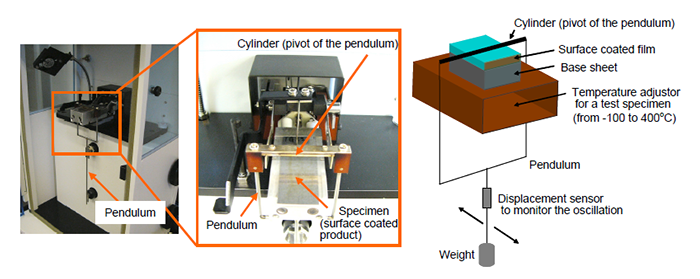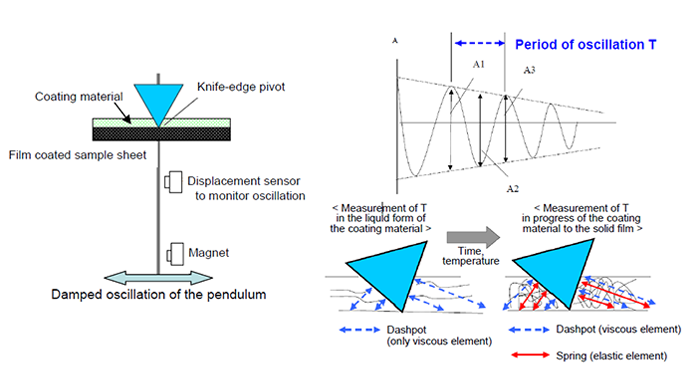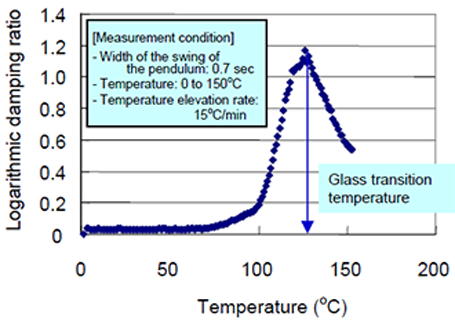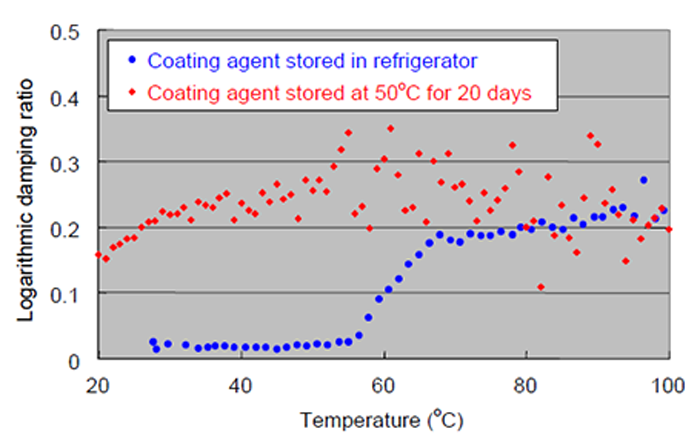Study and Analysis of a Root Cause of Failure
in Resin Composite Materials
Rigid-Body Pendulum Type Physical Properties Testing of Surface Coating
JET-TEC has the test equipment for measuring the glass transition temperature of the surface coating. JFE-TEC can also perform the long-term stability test on the coating materials.
Importance of Determination of the Glass Transition Temperature of Surface Coatings and Characteristics of the Rigid-Body Pendulum Test
- Various materials are studied to coat the surface of sheet materials such as steel, aluminum, resins, and glass for improvement of their surface properties. Since the properties of the material surface are affected by the glass transition temperature (Tg) of the material, accurate determination of Tg is very important in research and development of these sheets. As its measurement method it is known to remove the coating with a scraping tool and run the differential scanning calorimetry (DSC) with the scraped sample, but this method cannot be used in a very thin coating which is difficult to detect and accurately determine Tg.
- In the rigid-body pendulum test method scraping of the surface coating is not required and Tg of the surface coating can be clearly measured without sample modification.
Importance of a Long-Term Stability Test of the Surface Coating Material and Characteristic of the Rigid-Body Pendulum Test Method
- Sheet materials such as steel and glass are often coated with chemicals for rust prevention - and sealing. Coating materials are often stored for a few months before use and potentially degraded during storage. It is important to know whether or not the coating materials stored are as good as the fresh one.
- This technology uses the free damped oscillation of a rigid-body pendulum with the knife-edge pivot rested above the sample, allowing the evaluation of a change of viscoelastic properties of the coating materials over a period of time. In the case of emulsions the reaction initiation temperature to fuse coating particles can be determined, whereas in the case of the resin the initiation temperature to cure the resin can be determined. A fresh coating material is also similarly evaluated to compare with the sample stored.
What is the Rigid-Body Pendulum Test Method?
- The rigid-body pendulum test method is a method in which a pendulum with a rod-shape knife-edge pivot is swung back and forth to monitor the internal friction of the coating film while changing the temperature.

Outline of the Test Method by the Rigid-Body Pendulum with a Knife-Edge Pivot
- In the rigid-body pendulum test method the pendulum with a knife-edge pivot is swung back and forth while varying the temperature of the coating material and the period of oscillation of the pendulum is measured over a period of time to study the viscoelastic properties in progress of formation of the coated film

Measurement Example of the Glass Transition Temperature of Surface Coating Film
Measurement Principle of the Glass Transition Temperature of Surface Coating Film, and Measurement
-
A change of the amplitude or width of the swing in the pendulum is measured to determine the logarithmic damping ratio (viscous element/elastic element) of the surface coated film.
The temperature at which the logarithmic damping ratio becomes the maximum is the glass transition temperature of the coating material.Rolling motion of a pendulum (temperature variation at a certain period of time)
↓
Change of the logarithmic damping ratio (viscous element/elastic element) of the coated film
↓
A change of internal friction of the coated film
↓
A change of the width of the swing in the pendulum -
Measurement example of the glass transition temperature of the epoxy resin coated film on the zinc-coated (galvanized) steel sheet (film thickness: 3 µm)

Evaluation example of temporal stability of coating materials

-
Δ=[ln(A1/A2)+ln(A2/A3)+...+ln(An/An+1)]/n
Δ : Logarithmic damping ratio
A : Amplitude
n : Wavenumber -
Temperature at which the ratio of the elastic element to the viscous element becomes 0.1 or greater.
Coating agent stored at 20°C for 20 days Higher than approximately 20°C Coating reagent in a refrigerator Higher than approximately 60°C ⇒ Storage at 50°C cures parts of the coating agent, suggesting the degradation of the material with time.


